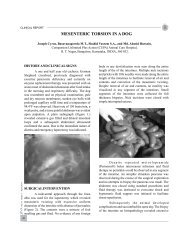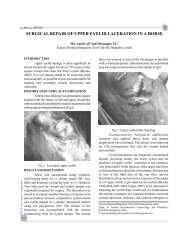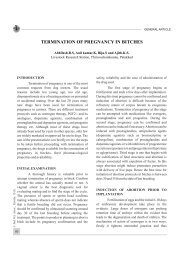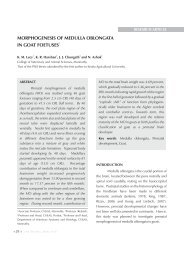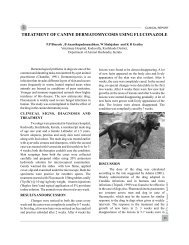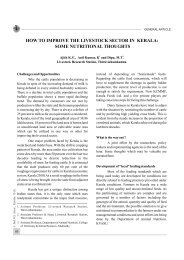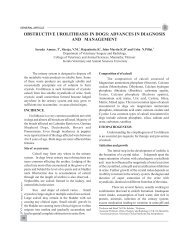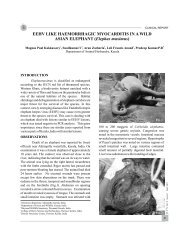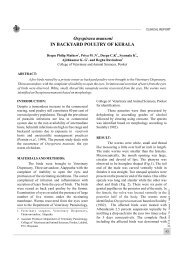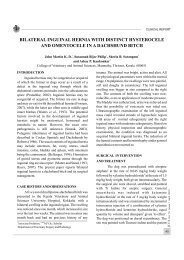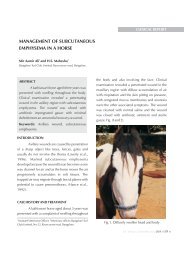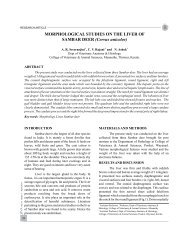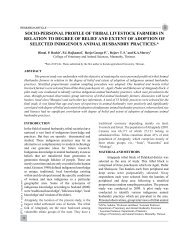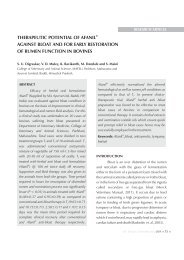2012 Jiva April Cover 220 GSM Art Card Glossy ... - Jivaonline.net
2012 Jiva April Cover 220 GSM Art Card Glossy ... - Jivaonline.net
2012 Jiva April Cover 220 GSM Art Card Glossy ... - Jivaonline.net
Create successful ePaper yourself
Turn your PDF publications into a flip-book with our unique Google optimized e-Paper software.
CLINICAL REPORTBILATERAL INGUINAL HERNIA WITH DISTINCT HYSTEROCELEAND OMENTOCELE IN A DACHSHUND BITCH1 2 3John Martin K. D. , Susannah Bijee Philip , Sherin B. Sarangom4and Ashay P. KankonkarCollege of Veterinary and Animal Sciences, Mannuthy, Thrissur, Kerala 680651INTRODUCTIONInguinal hernias may be congenital or acquiredof which the former in dogs occur as a result of adefect in the inguinal ring through which theabdominal contents protrudes into the subcutaneousspace (Pratschke, 2002). Inguinal hernias may becongenital or acquired. The former are rare in dogsand may co-exist with the umbilical hernias (Fossum,2007), while the latter are often seen in middle agedintact bitches (Waters et al., 1993). The potentialfactors involved in the development of inguinalhernias might be anatomical, hormonal andmetabolic in nature. However, the exact etiopathogenesisis still unknown (Smeak, 2003).Polygenic inheritance of inguinal hernia had beendescribed in Cocker Spaniels and Dachshunds byRoberts (1986). The usual contents of inguinal herniamay include omentum, fat, ovary, uterus, smallintestine, colon, bladder and spleen, with omentumbeing the commonest. (Bellenger, 1996). Herniationof gravid uterus and pyometra uterus through theinguinal ring are also report (Munro and Stead, 1993;Byers, 2007). The present paper reports bilateralinguinal hernia in a dachshund bitch and its surgicalmanagement.CASE HISTORY AND OBSERVATIONSA five year old nulliparous dachshund bitch waspresented to the Kerala Veterinary and AnimalSciences University Hospital, Kokkalai with abilateral swelling in the inguinal region. The swellingwas noticed since one month, which increased in sizeover the last two weeks. The animal was in estrus onemonth back and had no previous history of any1 2,3&4Associate Professor, M.V.Sc. ScholarDepartment of Veterinary Surgery and Radiologytrauma. The animal was bright, active and alert. Allthe physiological parameters were within the normalrange. On palpation, the swellings were non-painful,soft and doughy in consistency. The left inguinalswelling was bigger in size compared to the rightone. The contents of both the swelling were nonreducible,even on application of moderate pressure.The bladder was catheterized, urine was relieved andthus the possibility of vesicocele was ruled out.Ultrasonographic examination of the left inguinalmass could revealed strands of hypoechoic regionwith areas of normal echogenicity and the rightinguinal mass with moderate echogenicity. Based onhistory, physical inspection and ultrasonographicexamination, the condition was diagnosed as anacquired bilateral inguinal hernia. The reduction ofthe hernial contents and herniorrhaphy under generalanaesthesia were resorted to.SURGICAL INTERVENTIONAND TREATMENTThe dog was premedicated with atropineasulphate at the rate of 0.045 mg/kg body weightbfollowed by xylazine hydrochloride at the rate of 1.5mg/kg body weight, both given intramuscularly. Thethe surgical site ware shaved, scrubbed and paintedwith Tr Iodine for aseptic surgery. Generalanaesthesia was induced with ketaminechydrochloride at the rate of 5 mg/kg body weightintramuscularly and was maintained by incrementalintravenous injection of a combination of xylazinehydrochloride and ketamine hydrochloride, equaldquantity by volume and diazepam given 'to effect'.The dog was positioned on dorsal recumbency. Thesite was painted with Tincture iodine and the patientJIVA Vol. 10 Issue 1 <strong>April</strong> <strong>2012</strong>45



